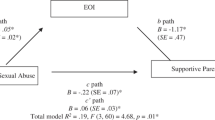Abstract
An assessment technique of having mothers and young adolescents describe in brief written form what they like and dislike about each other was evaluated. Distressed dyads (N=38) produced responses that were rated significantly more negative (Demanding, Personal Attack, Anger and Hostility, Complaining About Unfairness or Disrespect) and less positive (Good Relationship, Appreciation of Other, Complimentary, and Enjoyment) than nondistressed dyads (N=40). Evidence of reliability was reported. Ratings of the written responses correlated significantly with independently obtained codings of taperecorded interactions, thus offering support for validity of the method.
Similar content being viewed by others
References
Alexander, J. F. Defensive and supportive communications in normal and deviant families.Journal of Consulting and Clinical Psychology, 1973,40, 223–231. (a)
Alexander, J. F. Defensive and supportive communications in family systems.Journal of Marriage and the Family, 1973,35, 613–617. (b)
Bodin, A.Family interaction, coalition disagreement, and compromise in problem, normal, and synthetic triads. Unpublished doctoral dissertation, State University of New York at Buffalo, 1966.
Duncan, O. D. A socioeconomic index for all occupations. In A. J. Reiss (Ed.),Occupations and social status. New York: Free Press of Glencoe, 1961.
Ferreira, A., & Winter, W. Decision-making in normal and abnormal two-child families.Family Process, 1968,7, 17–36.
Jacob, T. Family interaction in disturbed and normal families: A methodological and substantive review.Psychological Bulletin, 1975,82, 33–65.
Oltmanns, T. F., Broderick, J. E., & O'Leary, K. D. Marital adjustment and the efficacy of behavior therapy with children.Journal of Consulting and Clinical Psychology, 1977,45, 724–729.
Patterson, G. R., & Hops, H. Coercion, a game for two: Intervention techniques for marital conflict. In R. E. Ulrich & P. Mountjoy (Eds.),The experimental analysis of social behavior. New York: Appleton-Century-Crofts, 1972. Pp. 424–440.
Patterson, G. R., & Reid, J. B. Reciprocity and coercion: Two facets of social systems. In C. Neuringer & J. L. Michael (Eds.),Behavior modification in clinical psychology. New York: Appleton-Century-Crofts, 1970. Pp. 133–177.
Prinz, R. J., & Kent, R. N. Recording parent adolescent interactions without the use of frequency or interval-by-interval coding.Behavior Therapy, 1978, in press.
Reid, J. B.Reciprocity and family interaction. Unpublished doctoral dissertation, University of Oregon, 1967.
Rutter, M., Graham, P., Chadwick, O. R. D., & Yule, W. Adolescent turmoil: Fact or fiction?Journal of Child Psychology and Psychiatry, 1976,17, 35–56.
Speer, D. C. Behavior Problem Checklist (Peterson-Quay): Baseline data from parents of child guidance and nonclinic children.Journal of Consulting and Clinical Psychology, 1971,36, 221–228.
Wiggins, J. S.Personality and prediction: Principles of personality assessment. Reading, Massachusetts: Addison-Wesley, 1973.
Winter, W., Ferreira, A., & Olson, J. Hostility themes in the family TATs.Journal of Projective Techniques and Personality Assessment, 1966,30, 270–274.
Author information
Authors and Affiliations
Additional information
The authors wish to thank Diane Follingstad and Peter Kilmann for their comments on an earlier draft.
Rights and permissions
About this article
Cite this article
Prinz, R.J., Rosenblum, R.S. & O'Leary, K.D. Affective communication differences between distressed and nondistressed mother-adolescent dyads. J Abnorm Child Psychol 6, 373–383 (1978). https://doi.org/10.1007/BF00924740
Revised:
Issue Date:
DOI: https://doi.org/10.1007/BF00924740




